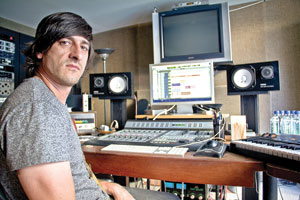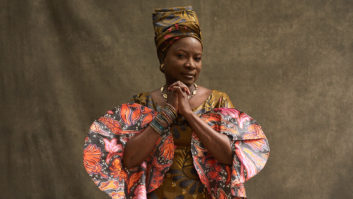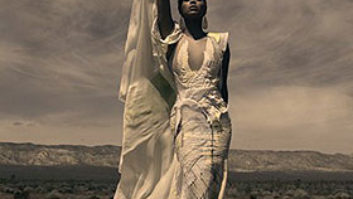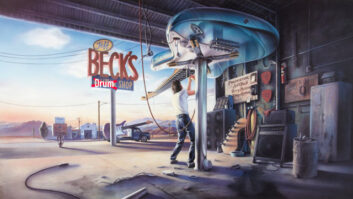
In 2012, producer/songwriter Jeff Bhasker turned over a new leaf, as his run of hits with top R&B/hip hop artists—including Alicia Keys’ “Try Sleeping With a Broken Heart,” Jay-Z’s “Run This Town,” Drake’s “Find Your Love,” Beyoncé’s “Rather Die Young” and Kanye West’s “All of the Lights”—led to projects with top acts in far different genres, including the Rolling Stones’ “Doom and Gloom,” Lana Del Rey’s Born to Die and Some Nights, his wildly successful collaboration with the previously obscure band fun. The latter resulted in sales of close to a million albums and more than 10 million tracks between “We Are Young” and the title song, according to SoundScan, leading to a Best New Artist Grammy for the band and a Song of the Year gramophone for “We Are Young,” shared by the co-writers—the three band members and Bhasker.
But long before those awards, he got a call from Taylor Swift, resulting in his producing two tracks on her massively successful album Red. He then undertook what is rapidly becoming his signature move, merging two distinct genres in the pairing of Dido and Kendrick Lamar on her current single “Let Us Move On.” His contributions to Keys’ Girl on Fire and Bruno Mars’ Unorthodox Jukebox, including both albums’ lead singles, topped off Bhasker’s remarkably diverse breakout year.
That a white kid from a small town in the middle of nowhere would earn the distinction of being the go-to guy for Kanye, Jay-Z, Beyoncé, Keys, Drake, Kid Cudi and other stars of contemporary black music is surprising, to say the least, but for Bhasker, it was just a matter of connecting the dots.
The Socorro, N.M., native cut his teeth on Hendrix, Santana, Pink Floyd, Led Zeppelin and Kiss before becoming transfixed by jazz when his piano teacher gave him a cassette with Oscar Peterson’s Night Train on one side and Chick Corea’s Hymn to the Seventh Galaxy on the other. “I was 12 or 13, and it was exactly what I’d been looking for,” he recalls. “The texture of those jazz chords was magical. Then I got heavily into Miles Davis and imagined myself in the jazz tradition where you’d practice playing and a bandleader like Miles would pick you up and you’d go to school under him.”
The notion of following in the footsteps of the jazz greats continued to motivate Bhasker, as he started writing charts for his own satisfaction on his PowerBook 520 using Overture, which also gave him his first taste of programming. Some friends then introduced him to the craft of making beats for rappers to freestyle over, and he came to view rapping as an extension of jazz improvisation. Making beats led Bhasker to try his hand at songwriting, and after graduating from Berklee College of Music, he moved to L.A. and got a job doing demos for renowned pop songsmith Diane Warren. “The experience helped me to appreciate the power of a great, well-written song,” he says. “That got me away from the mental masturbation that serious music can lead to, and I started trying to condense an idea into a digestible message.”

Bhasker got his big break in 2007, when Kanye West, impressed by the youngster’s ability to write, arrange, program, engineer and play any instrument by ear, hired him as music director for 2008’s Glow in the Dark tour, followed by a key role in the writing and recording of 808s and Heartbreak. “In a lot of ways,” says Bhasker, “Kanye ended up being my Miles Davis: he’s always innovating, he’s intelligent and he’s proud of being black but he also explores European music, fashion and life in an intellectual and soulful way.”
To say that Bhasker learned his lessons well would be an understatement, to say the least. These days, no producer is more in demand than the 28-year-old hit-maker. So it was that he found himself in a Paris studio last August with the Rolling Stones and longtime producer Don Was, co-producing “Doom and Gloom,” the band’s first new recording in seven years. The track both honors and subtly transforms the legendary band’s iconic sound, starting with Charlie Watts’ massive, walloping drums. Turns out Bhasker’s posse provided a bit of enhancement to the recording.
“The idea was to combine the room culture with what I do,” Bhasker explains. “The band cut the song live in the studio, and we got the files and we tempo-mapped Charlie’s performance. Then Emile Haynie, who did Lana Del Rey and the fun. album with us, did a drumbeat with his samples, which are like chopped-up bits from old records. Emile’s beat exactly follows Charlie—just kinda beefed up. On the original recording, the snare’s kinda ring-y, and the sound of the room accentuates that. So having our snare sample in there masks that ringiness and makes it more solid. With the kick, also, you don’t so much hear the drumhead; it makes the speaker go BONK. In hip-hop, people use speakers in a whole other capacity, so that’s part of it, too, compared to a normal rock recording.
“With drum programming, it’s just not fair,” he continues, riffing now. “You can put five different samples together and get the punch exactly right. I stopped using drummers because I have so much more control and it sounds so much more interesting. A little drumhead just ain’t gettin’ it nowadays—it’s 2013. Production is a snapshot in time. When you hear an older Stones record, you picture the ’60s. You see it in black-and-white, almost. Those beautiful recordings like ‘Gimme Shelter,’ the mood that it creates—it evokes that time. So the challenge was to make it still sound like the Stones but give it a contemporary spin. And there’s a couple editing breaks—a little one percent of Skrillex in that editing breakdown. We got into that, man. Mick was like, ‘Give it that swampy feel.’ So we added a Moog bass, which is a big staple of my productions, and we replayed the bassline a little heavier, me and Darrell Jones. And some owls on the bridge from Emile’s collection of animal sounds. I heard it on the radio, and it came out sounding killer.”
Like “Doom and Gloom,” the fun. project was a collision of cultures, the premise being to pair Nate Reuss’ heady pop songs with Bhasker’s visceral hip-hop beats. “When we met,” says the producer, “Nate told me that he’d varied the tempos in a lot of his songs, and he said, ‘I want to stop doing that. I want to put our music against a solid beat.’ So I was trying to stick to that and I made the beat, and we recorded him singing the verse with the same tempo as the chorus, over that beat. And as we listened to it, he said, ‘Oh, it doesn’t quite sound right. The verse needs to be faster.’ I got a little frustrated. I said, ‘But you said you wanted to do it against the beat.’ And then I realized—because I had been the music director for Lady Gaga and Kanye West—we used to do that for the shows. We’d do a Pro Tools session for the backing track for the show, with sound effects and stuff, and we’d change the tempo for each song. We had a big session for the whole show, a two-hour session with, like, 5,000 tracks stemmed out in quad sound. So I said to Nate, ‘You know what? You’re right.’ Elastic Audio had just come out on Pro Tools, and we used his same verse but sped it up. And if you listen closely, it has this supernatural quality to it, because it was recorded slower and then speeded up.”
With its brisk verses and measured choruses, “We Are Young” inverts the dynamic of so many recent EDM-based pop records, which progressively build the intensity in the pre-chorus with synths that sound like air raid sirens, setting up the requisite double-time chorus explosion. Perhaps that’s one of the reasons “We Are Young” sounded so fresh on the radio. “And it has a stellar hook—giving you something,” Bhasker points out.
There’s a similarly intriguing wrinkle on the follow-up smash, “Some Nights,” which for the most part consists of little more than an overdubbed choir against a supercharged martial beat, most dramatically displayed in the whoa-oh choruses. This combination of apparent melodic sparseness and pumped-up rhythmic muscle has enabled the track to fit comfortably alongside such alt-folk crossover hits as the Lumineers’ “Ho Hey” and Of Monsters and Men’s “Little Talks,” despite the fact that it’s coming from a far glossier idiom, more spandex than flannel.
“I consciously tried to check all the boxes,” Bhasker says, “not to prove a point but because I heard it in the music. That’s another thing I learned from Kanye. You want to be able to play a piece of music in any environment, in your apartment, your car, your club. Not every record can be everything, but it was interesting to have the opportunity to put those two worlds together.”
Bhasker’s indispensable pieces of hardware are his Moog Voyager, Juno-106, Roland MP60 and acoustic piano. “When I’m writing, they’re like my little band,” he says. He also has an ample assortment of mics; typically, he’ll connect a Sony C800 to a Neve or Chandler preamp and a Pultec EQ. But he adjusts his hardware according to the situation. “I use a handheld sometimes, too,” he says. “Dido sang the vocal to ‘Let Us Move On’ into an SM57 in the room with the speakers on—on my couch. Came out great. We tried redoing it. I brought in the best mic I could find, and the quality of the recording was better, but the performance wasn’t as good. It’s about capturing the performance; when the magic happens, you need to be ready to go to work.”
Having just completed his second album with English provocateur Natalia Kills, Bhasker intends to clear the decks and finish the solo album he’s been working on between projects for the last several years. It will bear the alias Billy Kraven, one of a number of stylistic alter egos Bhasker has dreamed up (his hip-hop alias, for example, is U.G.L.Y.). He’s uploaded a number of tracks from the nearly completed album—a loosely narrative song cycle about a G.I. during and after the Iraq War—on his Kravenworks YouTube page; powered by churning hip-hop beats and topped by his rangy, emotive classic-rock-evoking lead vocals, they sound ominous, melancholy and trippy in a Floydian way.
Does he hear himself in his body of work? Is there a Jeff Bhasker sound? “There’s definitely a sonic similarity between all the songs,” he answers. But I’m trying to evolve it, too. I’m always searching for two contrasting things—putting together things that aren’t supposed to go together. Those are always the most exciting things artistically, in any field.”







